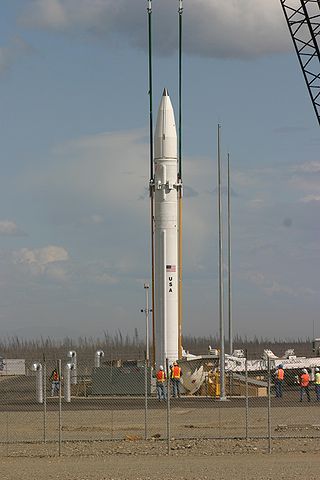
An anti-ballistic missile (ABM) is a surface-to-air missile designed to counter ballistic missiles. Ballistic missiles are used to deliver nuclear, chemical, biological, or conventional warheads in a ballistic flight trajectory. The term "anti-ballistic missile" is a generic term for a system designed to intercept and destroy any type of ballistic threat; however, it is commonly used for systems specifically designed to counter intercontinental ballistic missiles (ICBMs).

An intercontinental ballistic missile (ICBM) is a ballistic missile with a range greater than 5,500 kilometres (3,400 mi), primarily designed for nuclear weapons delivery. Conventional, chemical, and biological weapons can also be delivered with varying effectiveness, but have never been deployed on ICBMs. Most modern designs support multiple independently targetable reentry vehicle (MIRVs), allowing a single missile to carry several warheads, each of which can strike a different target. The United States, Russia, China, France, India, the United Kingdom, Israel, and North Korea are the only countries known to have operational ICBMs.
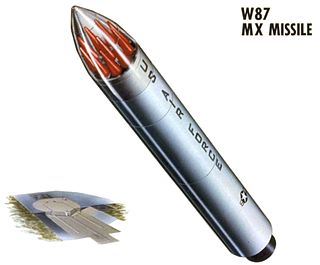
A multiple independently targetable reentry vehicle (MIRV) is an exoatmospheric ballistic missile payload containing several warheads, each capable of being aimed to hit a different target. The concept is almost invariably associated with intercontinental ballistic missiles carrying thermonuclear warheads, even if not strictly being limited to them. An intermediate case is the multiple reentry vehicle (MRV) missile which carries several warheads which are dispersed but not individually aimed. All nuclear-weapon states except Pakistan and North Korea are currently confirmed to have deployed MIRV missile systems. Israel is suspected to possess or be in the process of developing MIRVs.

National missile defense (NMD) refers to the nationwide antimissile program the United States has had in development since the 1990s. After the renaming in 2002, the term now refers to the entire program, not just the ground-based interceptors and associated facilities.

Terminal High Altitude Area Defense (THAAD), formerly Theater High Altitude Area Defense, is an American anti-ballistic missile defense system designed to shoot down short, medium, and intermediate-range ballistic missiles in their terminal phase by intercepting with a hit-to-kill approach. THAAD was developed after the experience of Iraq's Scud missile attacks during the Gulf War in 1991. The THAAD interceptor carries no warhead, instead relying on its kinetic energy of impact to destroy the incoming missile.

Missile defense is a system, weapon, or technology involved in the detection, tracking, interception, and also the destruction of attacking missiles. Conceived as a defense against nuclear-armed intercontinental ballistic missiles (ICBMs), its application has broadened to include shorter-ranged non-nuclear tactical and theater missiles.

The Safeguard Program was a U.S. Army anti-ballistic missile (ABM) system designed to protect the U.S. Air Force's Minuteman ICBM silos from attack, thus preserving the US's nuclear deterrent fleet. It was intended primarily to protect against the very small Chinese ICBM fleet, limited Soviet attacks and various other limited-launch scenarios. A full-scale attack by the Soviets would easily overwhelm it. It was designed to allow gradual upgrades to provide similar lightweight coverage over the entire United States over time.
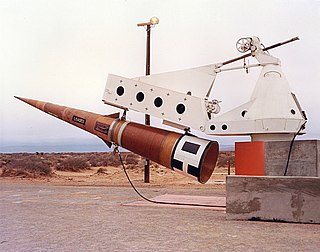
The Sprint was a two-stage, solid-fuel anti-ballistic missile (ABM), armed with a W66 enhanced-radiation thermonuclear warhead used by the United States Army during 1975–76. It was designed to intercept incoming reentry vehicles (RV) after they had descended below an altitude of about 60 kilometres (37 mi), where the thickening air stripped away any decoys or radar reflectors and exposed the RV to observation by radar. As the RV would be traveling at about 5 miles per second, Sprint needed to have phenomenal performance to achieve an interception in the few seconds before the RV reached its target.

An air-launched ballistic missile (ALBM) is a ballistic missile launched from an aircraft. An ALBM allows the launch aircraft to stand off at long distances from its target, keeping it well outside the range of defensive weapons like anti-aircraft missiles and interceptor aircraft. Historically, once launched the missile was essentially immune to interception due to a lack of capable anti-ballistic missiles, with those few that did exist being limited to known static positions. This combination of features allowed a strategic bomber to present a credible deterrent second-strike option in an era when improving anti-aircraft defences appeared to be rendering conventional bombers obsolete. However, by the 1990s surface-to-air missile technology had innovated to the point of allowing the interception of such weapons from road mobile systems, albeit at a lower PoK. By the early 21st century capable, dedicated, ABM systems from several nations had been deployed in significant numbers, spurring further innovation in hypersonic glide vehicles to penetrate such systems and keep ballistic missiles capable.

The RIM-161 Standard Missile 3 (SM-3) is a ship-based surface-to-air missile used by the United States Navy to intercept short- and intermediate-range ballistic missiles as a part of Aegis Ballistic Missile Defense System. Although primarily designed as an anti-ballistic missile, the SM-3 has also been employed in an anti-satellite capacity against a satellite at the lower end of low Earth orbit. The SM-3 is primarily used and tested by the United States Navy and also operated by the Japan Maritime Self-Defense Force.
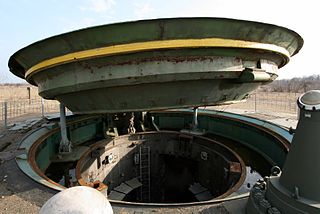
A missile launch facility, also known as an underground missile silo, launch facility (LF), or nuclear silo, is a vertical cylindrical structure constructed underground, for the storage and launching of intercontinental ballistic missiles (ICBMs), intermediate-range ballistic missiles (IRBMs), medium-range ballistic missiles (MRBMs). Similar facilities can be used for anti-ballistic missiles (ABMs).

The NATO missile defense system is a missile defense system being constructed by the North Atlantic Treaty Organization (NATO) in several member states and around the Mediterranean Sea. Plans for this system have changed several times since first studied in 2002, including as a response to Russian opposition.

Missile defense systems are a type of missile defense intended to shield a country against incoming missiles, such as intercontinental ballistic missiles (ICBMs) or other ballistic missiles. The United States, Russia, India, France, Israel, Italy, United Kingdom, China and Iran have all developed missile defense systems.
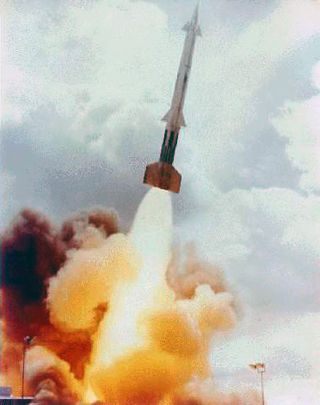
Nike Zeus was an anti-ballistic missile (ABM) system developed by the United States Army during the late 1950s and early 1960s that was designed to destroy incoming Soviet intercontinental ballistic missile warheads before they could hit their targets. It was designed by Bell Labs' Nike team, and was initially based on the earlier Nike Hercules anti-aircraft missile. The original, Zeus A, was designed to intercept warheads in the upper atmosphere, mounting a 25 kiloton W31 nuclear warhead. During development, the concept changed to protect a much larger area and intercept the warheads at higher altitudes. This required the missile to be greatly enlarged into the totally new design, Zeus B, given the tri-service identifier XLIM-49, mounting a 400 kiloton W50 warhead. In several successful tests, the B model proved itself able to intercept warheads, and even satellites.
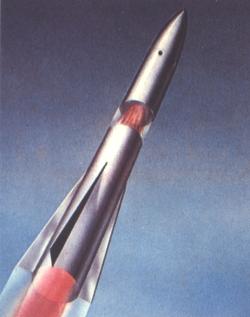
Project Wizard was a Cold War-era anti-ballistic missile system to defend against short and medium-range threats of the V-2 rocket type. It was contracted by the US Army Air Force in March 1946 with the University of Michigan's Aeronautical Research Center (MARC). A similar effort, Project Thumper, started at General Electric.
The DF-ZF is a hypersonic glide vehicle (HGV) developed by the People's Republic of China. It is launched by the DF-17 medium-range ballistic missile. The combined weapon system was likely operational by October 2019.

Nike-X was an anti-ballistic missile (ABM) system designed in the 1960s by the United States Army to protect major cities in the United States from attacks by the Soviet Union's intercontinental ballistic missile (ICBM) fleet during the Cold War. The X in the name referred to its experimental basis and was supposed to be replaced by a more appropriate name when the system was put into production. This never came to pass; in 1967 the Nike-X program was canceled and replaced by a much lighter defense system known as Sentinel.

Sentinel was a proposed US Army anti-ballistic missile (ABM) system designed to provide a light layer of protection over the entire United States, able to defend against small ICBM strikes like those expected from China, or accidental launches from the USSR or other states. The system would have seventeen bases, each centered on its Missile Site Radar (MSR) and a computerized command center buried below it. The system was supported by a string of five long-range Perimeter Acquisition Radars (PAR) spread across the US/Canada border area and another in Alaska. The primary weapon was the long-range Spartan missile, with short range Sprint missiles providing additional protection near US ICBM fields and PAR sites. The system would initially have a total of 480 Spartan and 192 Sprint missiles.

The Exoatmospheric Reentry-vehicle Interceptor Subsystem, or ERIS, program, was a component of the United States' Strategic Defense Initiative during the Cold War. The ERIS system was named after Eris, Greek goddess of strife. ERIS was a kinetic kill system, launched from a ground-based system, and impacting directly to destroy an incoming Intercontinental ballistic missile (ICBM) before the targeted ICBM re-entered the Earth's atmosphere.
Project BAMBI was a project as part of the United States national missile defense.

















